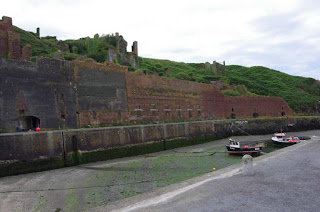Day 31 20/7/19 St Davids, Pembrokeshire (West Wales).
We had planned on doing the two hour boat tour of Skomer
Island today, home of about 6,000 pairs of Puffins. Unfortunately, after yesterday’s
inclement weather it was to rough out in the sound, they weren’t sure they
would be able to even get the boats to the dock in St Justinians. Anyway, by
12PM we managed to board the rubber ducky for the one hour tour around part of
Ramsey Island.
 |
| One minute, farm land and delightful scenery |
 |
| Next minute, chaos. St Davids Main Street, about 10Am Saturday morning. |
 |
| Speed limit 60MPH, fortunately most people do about 20-30MPH. |
 |
| Not quite as scary without the hedges |
 |
| St Justinians Life Boat Station |
 |
| Royal Navy Lifeboat being retrieved |
 |
| View out to Ramsay Islanbd |
 |
| St Justinians Chapel (Medieval) |
Ramsey Island was an ecclesiastical holding under the
stewardship of St Davids Cathedral from 1082 until 1905 when it was sold into
private hands. During this time it was farmed for both crops and animals, at
one time being a deer farm. The island, since 1992, has been owned by the Royal Society for
the Protection of Birds and has a full time Warden. Unfortunately, for Maritta,
early in the 19
th century a number of shipwrecks meant the island
was infested by rats who destroyed the Puffin Colony. Although the rats where “ERATICATED”
(blame our boat guide for that one) many years ago, the Puffins have not
returned. Was an excellent tour even without Puffins.
 |
| Approaching a cave, the cave system under the island is huge, |
 |
| Female seal curious about the intruders in her domain |
 |
| Whiskers are vastly more sensitive than those of a cat |
 |
| Another cave under the island |
 |
| Oyster Catcher sunning itself (and below) |
 |
| The island has a wide variety of geological formations |
 |
| Harbour, prior to this being built all visitors and goods had to be winched up the cliffs. |
 |
| View of the Warden's house and 19th century farmhouse. |
 |
| More seals |
 |
| These are in bachelor bay, the only place where unattached males congregate |
 |
| We didn't go out there it was to rough |
 |
| Returning to the Lifeboat station |
Then we went to visit Porthgain, about 6 miles North of St
Davids. This is the site of first a slate quarry, then a brickworks, and later
a stone quarry. One does wonder, given the terrain, why it would be here, just
the difficulty of getting the product out would seem not worth the effort. A
protected wharf was built which helped. Slate was extracted from 1850 to 1910, at
some point the quarry got to deep so they built a tunnel to transport the slate
(and waste) by train to the harbour and brickworks.
 |
| Porthgain Harbour, tide is on its way out |
 |
| Looking down on the harbour from the cliffs above Porthgain |
 |
| Stone pylon to guide boats into the harbour |
 |
| Very colourful pollen collector |
 |
| Brick building on the cliffs above the gravel pit |
From 1889 to 1912 a brick works was active and the bricks
are quite unique in that you can see the small slate granules unlike normal
bricks which have a spherical or almost invisible structure. From 1889 until 1931
a stone quarry was also in operation.
 |
| Look closely, you can see the "planer" structure of slate waste |
 |
| View towards Ireland, stone quarry is to the left. |
 |
| Slate Quarry |
 |
| Raven in the car park |
 |
| Oyster catcher on the boat ramp |











































No comments:
Post a Comment